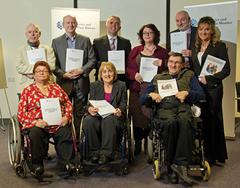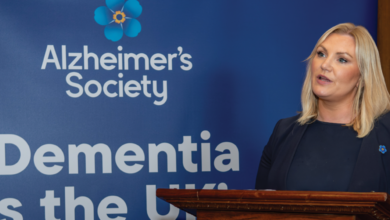Draft disability strategy
 A draft disability strategy agreed by the Executive contains 16 priorities for improving disabled people’s lives but is falling behind schedule.
A draft disability strategy agreed by the Executive contains 16 priorities for improving disabled people’s lives but is falling behind schedule.
A strategy aimed at helping disabled people to contribute to and benefit equally from Northern Ireland’s cultural, social, political and economic life has been published for consultation by the Executive.
Shaped by a report by the Executive’s Promoting Social Inclusion Working Group’s report on disability, published in December 2009, ‘A strategy to improve the lives of disabled people’ outlines 16 priorities, including:
• improved interaction between sectors to achieve the social inclusion of disabled people;
• increased awareness of rights;
• challenging negative perceptions about disabled people;
• eliminating barriers to places, goods and services faced by disabled people;
• increased choice, control and freedom for disabled people in their daily lives;
• reduced poverty and ensuring that families with disabled children have appropriate support; and
• more opportunities for disabled people to acquire skills and qualifications through training and lifelong learning.
While it has a 2012-2015 timescale, consultation will finish on 15 August this year and the final strategy may therefore not be approved until later this year or early 2013.
On the goal of independent living, the document states that while the Supporting People Programme offers a range of housing support services, currently “there is no widespread independent living programme here”. OFMDFM aims to “get Executive departments to work together more effectively” to develop such programmes.
An emphasis on qualifications alone “has the potential to restrict opportunities and choice”, it states. Additional non-qualification based forms of learning (e.g. supported work placements) should be recognised. The final strategy will set out actions to promote education, vocational training and employment opportunities, and safeguard existing jobs.
Combating and preventing poverty is highlighted: “For those who are not able to work the benefits system should ensure that their families do not experience poverty.”
The document claims to deliver the requirements of the UN Convention on the Rights of Persons with Disabilities, which the UK Government ratified in 2009. Its priorities reference the convention’s relevant articles.
It also notes that, in Q3 2011, one-third of those economically inactive (27.1 per cent) cited sickness or disability as the main reason for not working. The economic downturn has seen a decline in the number of work placements available and increased insecurity for disabled people with work. Households with disabled adults or children are more likely to be in poverty, while “many people have expressed concern that DLA [disability living allowance] does not cover all the extra costs of living with a disability.”
Continued increases in the cost of living and spending cuts across departments disproportionately affect the lives of disabled people, the draft strategy acknowledges. Society also has a poor or unsatisfactory understanding and acceptance of disability.
The document also outlines recent policies and legislation aimed at improving disabled people’s lives, including the Physical and Sensory Disability Strategy and Action Plan 2012-2015.
Launching the document, Junior Minister Jonathan Bell said: “More than one in five people here live with a disability. The numbers are growing and they represent a proportion of our population whose particular needs deserve our full attention.” The 2007 ‘Northern Ireland Survey of people with Activity Limitations and Disabilities’ found that 18 per cent of people in private households had a disability.
Chief Executive of Disability Action Monica Wilson said that it is implementation of the strategy “that will really demonstrate how this government will deliver rights for disabled people in Northern Ireland.”
An OFMDFM spokesman declined to comment on why it took 28 months (after the working group’s report was completed) to publish the strategy.





